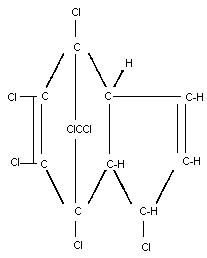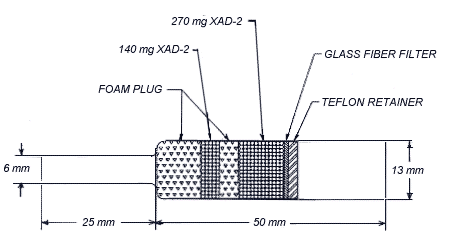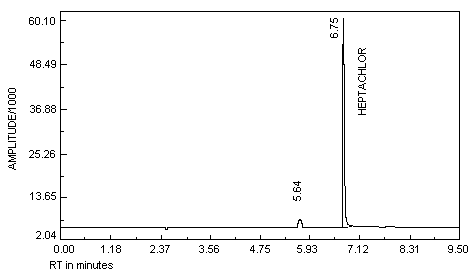HEPTACHLOR
| Method number: | PV2029 |
| Matrix: | Air |
| Target Concentration: | 0.5 mg/m3 OSHA permissible exposure limit (PEL). |
| Procedure: | Samples are collected by drawing known volumes of air through OSHA versatile sampler (OVS-2) tubes, each containing a glass fiber filter and two sections of XAD-2 adsorbent. Samples are desorbed with toluene and analyzed by gas chromatography (GC) using an electron capture detector (ECD). |
| Recommended air volume and sampling rate: |
60 L at 1.0 L/min |
| Detection limit of the overall procedure (based on the recommended air volume and the analytical detection limit): |
0.49 µg/m3 |
| Status of method: | Stopgap method. This method has been partially evaluated and is presented for information and trial use only. |
| Date: June 1989 (Final) | Chemist: Ing-Fong Chan |
Carcinogen and Pesticide Branch
OSHA Analytical
Laboratory
Salt Lake City, Utah
1. General Discussion
- 1.1. Background
- 1.1.1. History of procedure
This evaluation was undertaken to determine the effectiveness of the OVS-2 tube as a sampling device for heptachlor. It follows the procedure developed for chlordane. (Ref. 5.1.)
1.1.2. Toxic effects (This section is for information only and should not be taken as the basis of OSHA policy.)
Heptachlor has an acute oral LD50 of 40-188 mg/kg and an acute dermal LD50 of 119-320 mg/kg for rats. (Ref. 5.2. to 5.4.) Animal studies indicating clearly the carcinogenicity in mice and rats have been reported. (Ref. 5.2. to 5.4.) Due to these and other factors the ACGIH has set a threshold limit value (TLV) of 0.5 mg/m3 for heptachlor with a skin notation. (Ref. 5.4.) This level has also been adopted as the OSHA PEL.
1.1.3. Potential workplace exposure
Heptachlor is used as an insecticide. In the United States a total of 2.3 million kg of heptachlor was produced in 1980. (Ref. 5.2.) No information could be found on the number of workers exposed to heptachlor.
1.1.4. Physical properties (Ref. 5.2. to 5.6.)
| CAS number: | 76-44-8 |
| IMIS number: | 1369 |
| Molecular weight: | 373.35 |
| Molecular formula: | C10H5Cl7 |
| Boiling point: | 135-145°C |
| Solubility: | Practically insoluble in water (0.056
mg/l); soluble in ethanol (4.5 g/100 ml), xylene (102 g/100 ml), carbon tetrachloride (112 g/100 ml), acetone (75 g/100 ml) and benzene (106 g/ml). |
| Chemical name: | 1,4,5,6,7,8,8-Heptachloro-3a,4,7, 7a-tetrahydro-4,7-methano-lH-indene |
| Synonyms:
3-Chlorochlordene;
| |
| Trade names: | Aahepta; Agroceres; Drinox; E 3314; ENT 15,152; GPKh; H34; Heptachlorane; Heptagran; Heptamul; Rhodiachlor; Velsicol 104 |
| Appearance: | white, crystalline solid |
| Structure: |  |
1.2. Limit defining parameters
The detection limit of the analytical procedure, including a 17:1 split ratio, is 0.43 pg per injection. This is the amount of analyte which will give a peak whose height is approximately five times the baseline noise.
2. Sampling Procedure
- 2.1. Apparatus
- 2.1.1. A personal sampling pump that can be calibrated to within
± 5% of the recommended flow rate with the sampling device in line.
2.1.2. OVS-2 tubes, which are specially made
2.2. Reagents
No sampling reagents are required.
2.3. Sampling technique
- 2.3.1. Immediately before sampling, remove the plastic end caps
from the
2.3.2. Attach the small end of the tube to the sampling pump with flexible tubing.
2.3.3. Attach the tube vertically in the employee's breathing zone in such a manner that it does not impede work performance.
2.3.4. After sampling for the appropriate time, remove the tube and seal with plastic caps.
2.3.5. Wrap each sample end-to-end with an OSHA seal (Form 21).
2.3.6. Record the air volume for each sample, and list any possible interferences.
2.3.7. Submit at least one blank for each set of samples. Handle the blank in the same manner as the samples, except no air is drawn through it.
2.3.8. Submit bulk samples for analysis in a separate container. Limit the amount of bulk submitted to one gram or one ml. Do not ship them with air samples.
2.4. Desorption efficiency (glass fiber filter and XAD-2 adsorbent)
Fifteen vials, each containing a 13-mm glass fiber filter and
Desorption Efficiency
|
| |||||
Sample # |
Amount Spiked, µg |
Amount Found, µg |
% Recovered | ||
| D1 D2 D3 D4 D5 |
14.80 14.80 14.80 14.80 14.80 |
14.12 15.05 13.84 14.77 15.88 |
95.4 101.7 93.5 99.8 107.3 | ||
| D6 D7 D8 D9 D10 |
29.50 29.50 29.50 29.50 29.50 |
29.50 30.78 30.48 30.58 30.83 |
100.0 104.3 103.3 103.7 104.5 | ||
| D11 D12 D13 D14 D15 |
59.00 59.00 59.00 59.00 59.00 |
58.30 58.86 58.73 58.61 58.69 |
98.8 99.8 99.5 99.3 99.5 | ||
| |||||
|
| |||||
2.5. Retention efficiency
Six OVS-2 tubes were each liquid spiked with 20 µl (2× PEL) of a 2.95 mg/ml solution of heptachlor in toluene. These were allowed to dry for 2 hours and then 60 L of humid air (~80% relative humidity) were drawn through each tube at 1 L/min. The tubes were stored overnight in a drawer at ambient temperature, desorbed vith 4.0 mL of toluene, shaken for 30 min and then analyzed as in Section 3. The results are listed in Table 2.5.
Retention Efficiency
|
| |||
Sample # |
Amount Spiked, µg |
Amount Found, µg |
% Recovered |
| R1 R2 R3 R4 R5 R6 |
59.00 59.00 59.00 59.00 59.00 59.00 |
58.17 57.02 58.77 58.57 58.07 59.21 |
98.6 96.6 99.6 99.3 98.4 100.4 |
| Average = 98.8 | |||
|
| |||
2.6. Sample storage
Twenty four OVS-2 tubes were each liquid spiked with 10 µl (1× PEL) of 2.95 mg/ml of heptachlor. These were allowed to dry for 2 hours and then 60 L of humid air (~80% relative humidity) were drawn through each tube at 1 L/min. Half of the tubes were stored in a drawer at ambient temperature, and the other half were stored in a freezer (-5°C). They were extracted and analyzed as in Section 3. The results are given in Tables 2.6.1. and 2.6.2.
Retention Efficiency
|
| |||||
| Days Stored |
Amount Spiked, µg |
Amount Found, µg |
% Recovered | ||
| 0 0 0 |
29.50 29.50 29.50 |
28.99 28.99 29.72 |
98.3 98.3 100.7 | ||
| 4 4 4 |
29.50 29.50 29.50 |
26.32 28.77 29.53 |
89.2 97.5 100.1 | ||
| 7 7 7 7 7 7 |
29.50 29.50 29.50 29.50 29.50 29.50 |
28.14 29.06 29.54 28.77 28.78 29.88 |
95.4 98.5 100.1 97.5 97.6 101.3 | ||
| |||||
|
| |||||
Freezer Storage
|
| |||||
| Days Stored |
Amount Spiked, µg |
Amount Found, µg |
% Recovered | ||
| 0 0 0 |
29.50 29.50 29.50 |
29.48 28.09 29.67 |
99.9 95.2 100.6 | ||
| 4 4 4 |
29.50 29.50 29.50 |
27.53 29.35 25.47 |
93.3 99.5 86.3 | ||
| 7 7 7 7 7 7 |
29.50 29.50 29.50 29.50 29.50 29.50 |
29.55 29.93 30.53 29.86 29.68 29.13 |
100.2 101.5 103.5 101.2 100.6 98.7 | ||
| |||||
|
| |||||
2.7. Recommended air volume and sampling rate
- 2.7.1. The recommended air volume is 60 L.
2.7.2. The recommended flow rate is 1.0 L/min.
2.8. Interferences (sampling)
It is not known if any compounds will interfere with the collection of heptachlor. Any suspected interferences should be reported to the laboratory.
2.9. Safety precautions (sampling)
- 2.9.1. Attach the sampling equipment in such a manner that it
will not interfere with work performance or employee safety.
2.9.2. Follow all safety practices that apply to the work area being sampled.
3. Analytical Procedure
- 3.1. Apparatus
- 3.1.1. A balance capable of weighing to the nearest tenth of a
milligram. A Mettler HL52 balance was used in this evaluation.
3.1.2. A mechanical shaker.
3.1.3. A GC equipped with an ECD. A Hewlett Packard (HP) 5890 equipped with an autosampler was used in this evaluation.
3.1.4. A GC column capable of separating heptachlor from any interferences. A 45 m × 0.25 mm i.d. (0.25 µm film) SE-54 capillary column was used in this evaluation.
3.1.5. An electronic integrator, or some other suitable means for measuring detector response. The Hewlett-Packard 3357 Laboratory Data System was used in this evaluation.
3.1.6. Volumetric flasks and pipets.
3.1.7. Vials, 2-mL, and 4-mL.
3.2. Reagents
- 3.2.1. Toluene, reagent grade.
3.2.2. Heptachlor, reagent grade. A standard obtained from EPA (EPA # 3860, 99.8% purity) was used in this evaluation. .
3.3. Standard preparation
Prepare stock standards by adding toluene to preweighed amounts of heptachlor. Prepare working range standards by diluting stock standards with toluene. Store stock and working standards in a freezer.
3.4. Sample preparation
- 3.4.1. Transfer the 13-mm glass fiber filter and the 270-mg
sampling section of the tube to a 4-mL vial. Place the first foam
plug and the 140-mg backup section in a separate 4-mL vial. A small
glass funnel can be used to facilitate the transfer of the
adsorbent. Discard the rear foam plug. Do not discard the glass
sampling tube; it can be reused.
3.4.2. Add 4.0 mL of toluene to each vial and seal with a Teflon-lined cap.
3.4.3. Shake the vials for 30 minutes on a mechanical shaker.
3.4.4. If necessary, transer the samples to 2-mL vials for use on an HP autosampler.
3.5. Analysis
- 3.5.1. Instrument conditions
| Column: | SE-54, 45 m × 0.25 mm i.d., 0.25 µm film |
| Injector temperature: | 250°C |
| Column temperature: | 230°C |
| Detector temperature: | 300°C |
| Gas
flows: Column: ECD make up: |
2.14 mL/min hydrogen 20 mL/min nitrogen |
| Injection volume: | 1 µL |
| Split ratio: | 17:1 |
| Retention time: | 6.75 min |
3.5.2. Chromatogram (Figure 2.)
3.6. Interferences (analytical)
- 3.6.1. Any collected compound having a similar retention time to
that of the analyte is a potential interference.
3.6.2. GC conditions may generally be varied to circumvent interferences.
3.6.3. Retention time on a single column is not proof of chemical identity. Analysis by an alternate GC column, high performance liquid chromatography (HPLC) and confirmation by mass spectrometry are additional means of identification.
3.7. Calculations
- 3.7.1. Construct a calibration curve by plotting detector
response versus standard concentration (µg/mL) of heptachlor.
3.7.2. Determine the µg/mL of heptachlor in both sections of each sample and blank from the calibration curve.
3.7.3. Blank correct each sample by subtracting the µg/mL found in each section of the blank from the µg/mL found in the corresponding sections of the sample and then add the two sample sections together.
3.7.4. Determine the air concentration by using the following formula.
| mg/m3 = | (µg/mL, blank corrected) ×
(desorption volume, mL)
(air volume, L) × (desorption efficiency, decimal) |
3.8. Safety precautions (analytical)
- 3.8.1. Avoid skin contact and air exposure to heptachlor.
3.8.2. Avoid skin contact with all solvents.
3.8.3. Wear safety glasses at all times.
4. Recommendation for Further Study
This method should be fully validated.
5. References
- 5.1. Burright, D.; Method #67, "Chlordane
(Technical Grade)"; OSHA Analytical Laboratory, 1987; unpublished.
5.2. IARC Monographs on the Evaluation of the
Carcinogenic Risk of Chemicals to Humans; International Agency for
Research on Cancer: Lyon, 1979; Vol. 20, pp
5.3. Registry of Toxic Effects of Chemical
Substances
5.4. Documentation of the Threshold Limit Values and Biological Exposure Indices, American Conference of Governmental Industrial Hygienist INC., fifth edition, 1986; p 296.
5.5. Farm Chemicals Handbook; Berg, Gordon L. Ed.; Meister: Willoughby, Ohio, 1986; p C123.
5.6. Merck Index, 10th ed.; Windholz, Martha ED.; Merck: Rahway, N.J., 1983; p 673.

